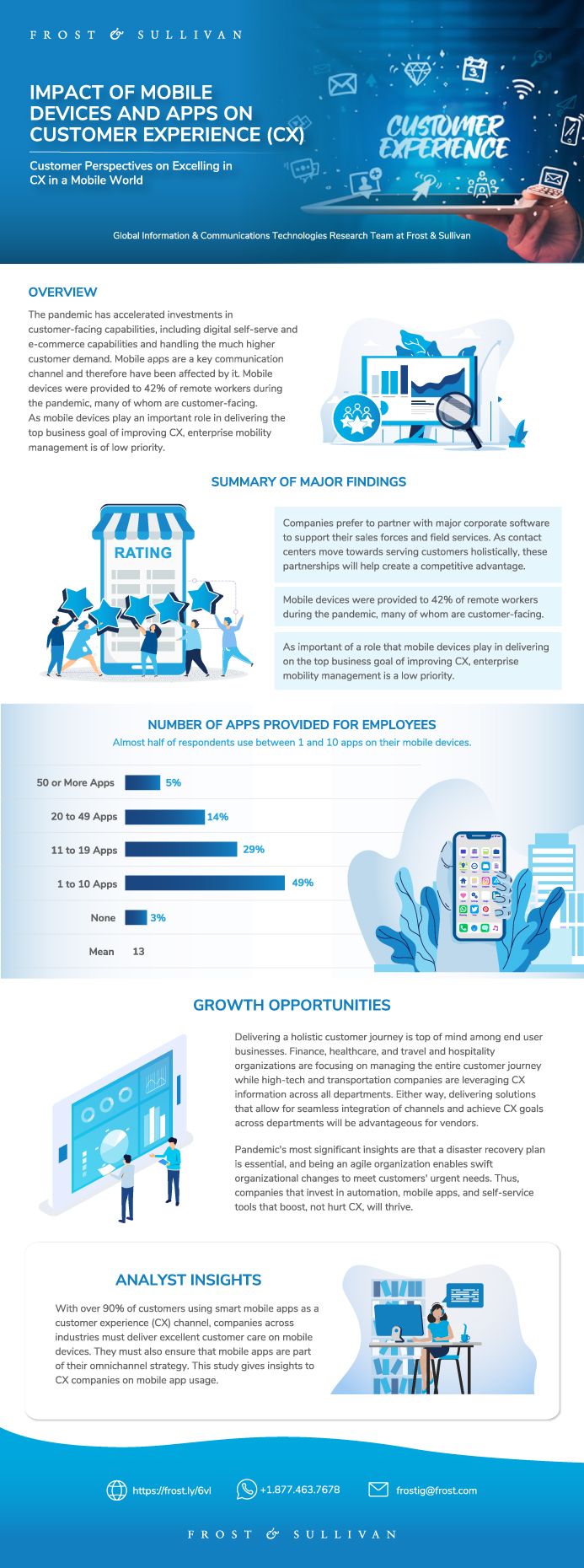Impact of Mobile Devices and Apps on Customer Experience (CX)
Impact of Mobile Devices and Apps on Customer Experience (CX)
Customer Perspectives on Excelling in CX in a Mobile World
16-Dec-2021
Global
$4,950.00
Special Price $3,712.50 save 25 %
Description
With over 90% of customers using smart mobile apps as a customer experience (CX) channel, companies across industries must deliver excellent customer care on mobile devices. They must also ensure that mobile apps are part of their omnichannel strategy.
This study gives insights to CX companies on mobile app usage.
The pandemic has accelerated investments in customer-facing capabilities, including digital self-serve and e-commerce capabilities, and handling the much higher customer demand. Mobile apps are a key communications channel and therefore have been affected. Mobile devices were provided to 42% of remote workers during the pandemic, many of whom are customer-facing. As important of a role that mobile devices play in delivering on the top business goal of improving CX, enterprise mobility management is a low priority. Without usage, investments in technologies are not fruitful. Companies are training and supporting employees so they learn how to use these apps to perform their jobs better. They are also preventing usage of apps that are not company-approved, which allows them to attain a solid ROI as well as reduces security risks. Support for Bring Your Own Devices (BYOD ) continues to increase year over year; the move to remote work among contact center agents has expanded their usage. Companies prefer to partner with major corporate software to support their sales forces and field services. As contact centers move towards serving customers holistically, these partnerships will help create a competitive advantage. Security features are a top priority when purchasing applications and devices.
Industries included in this survey include: agriculture/food and beverages, banking/finance/insurance, education, energy and utilities, government
healthcare (pharma, medical devices, HC facilities), high tech, manufacturing, retail/wholesale, transportation/storage, travel and hospitality, and
professional services.
This study is part of a larger study that included 3,284 respondents covering a broad set of IT solutions. The mobile apps and devices section included 777 respondents across verticals, business sizes. and regions.
Author: Shibapriya Saha
RESEARCH: INFOGRAPHIC
This infographic presents a brief overview of the research, and highlights the key topics discussed in it.Click image to view it in full size

Table of Contents
Research objectives
Benefits of Research
Research Methodology
Sample Distribution—Country
Introduction
Technology Initiatives Prioritized by Organizations Worldwide for CX Improvement in the United States in 2021
Most Common Customer Contact Channels Used by Organizations in the United States in 2021
Summary of Major Findings
Key Business Goals
Covid-19 Impact on Digital Transformation Objectives
Covid-19 Impact on Technologies for Remote Workers
Future Investment Prioritization
Number of Apps Provided for Employees
Plans to Introduce Additional Apps
Worker Categories Equipped with Apps
Tactics to Encourage Apps Usage
Unauthorized Apps Usage
Top Reasons for Not Providing Apps to Employees
Top Reasons for Providing Apps to Employees
Company Support for BYOD
Support for Mobile Operating Systems
Preferred Strategic Partner for Mobile Apps
Top Potential Benefit of 5G Connectivity
Preference as Regards Mobile Apps Deployment
Selection Criteria of Mobile Apps Partner
Mobile Worker Applications and Devices—Investment Factors
Growth Opportunities
Respondent Profile—Decision-Making Authority
Respondent Profile—Familiarity with IT Budget
Respondent Profile—Involvement in IT-Related Purchases
Organization Profile—Industry Segments
Organization Profile—Size of Organization
Organization Profile—Top IT-Related Challenges
Top Priorities for Digital Transformation Investment
Departments Driving the Adoption of Digital Solutions
Growth Opportunities Fuel the Growth Pipeline Engine™
Why is it Increasingly Difficult to Grow?
The Strategic Imperative 8™
List of Exhibits
List of Exhibits (continued)
Legal Disclaimer
| No Index | No |
|---|---|
| Podcast | No |
| Author | Alpa Shah |
| Industries | Information Technology |
| WIP Number | MFF8-01-00-00-00 |
| Is Prebook | No |
| GPS Codes | 9705-C1,9661 |
 USD
USD GBP
GBP CNY
CNY EUR
EUR INR
INR JPY
JPY MYR
MYR ZAR
ZAR KRW
KRW THB
THB